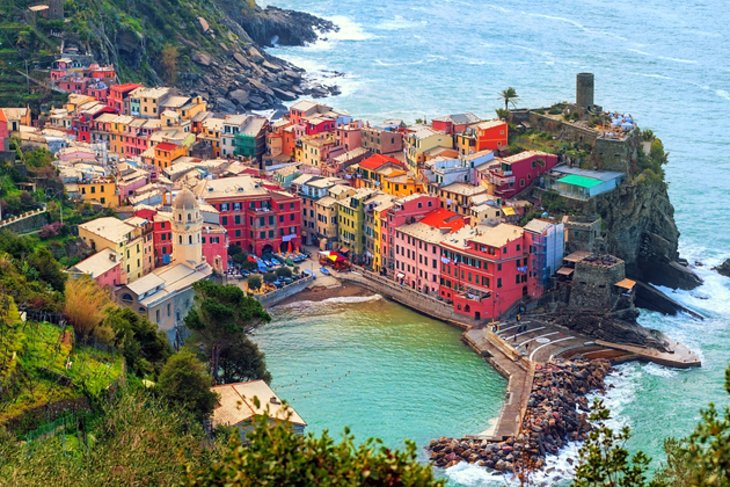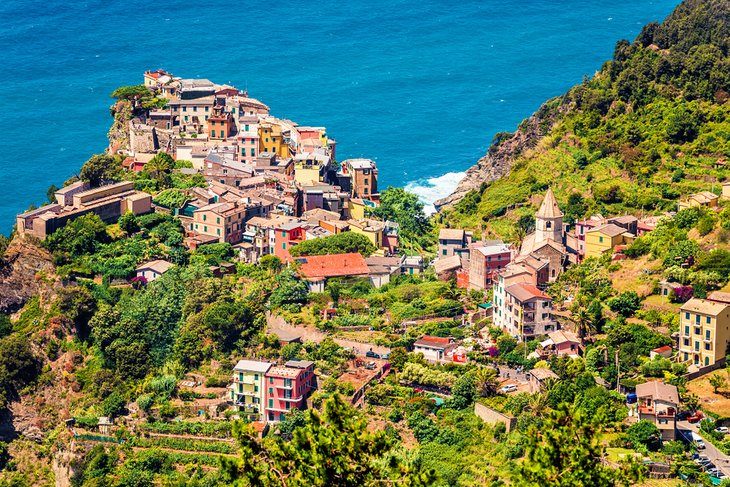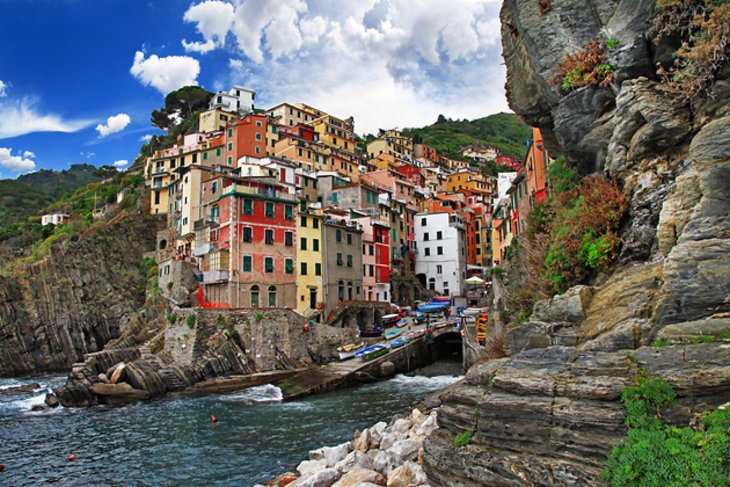Cinque Terre
Visiting the 5 Towns of the Cinque Terre: The Essential Guide
Few places in Italy are as memorable as the Cinque Terre, a land and culture so unique that it has been protected as a national park and designated a UNESCO World Heritage Site. Perhaps what travelers like best is its almost complete lack of traditional must-see sights such as important artworks, churches, palaces, museums, and castles. Instead, the ambience and natural beauty are the attractions. Popular things to do include walking the breathtaking paths along the cliffs, pausing over gelato in a café surrounded by candy-colored houses, cooling off with a swim, capturing pictures of some of Italy's best views, and just absorbing the Old World charm.
Until the 1960s, these five towns in the cliffs of the Riviera di Levante, between La Spezia and Levanto on the Gulf of La Spezia, were virtually unknown to tourists and difficult to reach, except by boat. Even today, a car is more of a liability than an asset when visiting the five towns of the Cinque Terre and seeing the coast's attractions. Trains and boats (in good weather) connect the five towns and run frequently. If you have time to see only a few, Vernazza and Riomaggiore are the most photo-worthy and atmospheric and perhaps the best places to visit in the Cinque Terre.
Walking the Cinque Terre
If you possibly can, walk at least one portion of the path carved in the cliffs between the villages. The shortest and widest of these connects Riomaggiore and Manarola, called, in typical Italian fashion, Via dell'Amore (Path of Love). It's also the most crowded, so if you visit in high season and seek more solitude, walk another section. Maps are available in park offices (at train stations) where you need to buy an entrance ticket to use the trails. It is also essential to stop there to check the condition of trails and to understand that any or all of them may be closed due to weather or damage. The prime experience is to hike the entire 12-kilometer Sentiero Azzurro from Monterosso to Riomaggiore, but only for those in good condition with proper boots and no fear of heights. The trail is often very narrow and skirts the face of vertical cliffs with no barriers between hikers and the sea crashing far below.
1 Monterosso al Mare
The largest of the five towns is Monterosso al Mare. It is less photogenic but the only one with a sizable beach. In the old part of the town, near the train station, are the 14th-century Loggia del Podestà and the parish church of San Giovanni Battista, whose campanile was built as a Genoese watch-tower. On a crag above the sea, the medieval Torre Aurora was built to protect the town from frequent pirate attacks. High above, on the road to Vernazza, the pilgrimage church of the Madonna di Soviore has a painted Baroque interior and spectacular views.
2 Vernazza
The prettiest of the five villages snuggles in a cleft between rocky cliffs, with colorful houses that seem to be stacked atop each other along its steep, narrow main street. Everything spills into a very pretty little piazza, and below it, little boats bob in the rocky harbor basin when they are not pulled up into the piazza itself. Scenes don't get much better, nor do places from which to enjoy them. A round tower and a few sections of the old Genoese fortification walls are a reminder of Genoa's war with Pisa in the 1100s. For the best views, climb the steps to the headland opposite the tower and look back.
3 Corniglia
The only one of the Cinque Terre without a harbor, Corniglia stands more than 182 meters above the sea. Also unlike the others, visitors arriving by train must climb up instead of descending into the village. At the top of the 300-plus steps (which are terraced and not very steep), the church of San Pietro is on the right. It is a good example of the local Gothic style built in the early 1300s, with a painted interior, a 12th-century baptismal font, and a painted altarpiece.
4 Manarola
Claim a table in one of the little restaurants in the piazza and savor just-caught seafood with a view over the miniature harbor. Above, the 1338 Gothic church of the Natività di Maria Vergine (also called the church of San Lorenzo) has a beautiful rose window of Carrara marble. Opposite the church are its free-standing bell-tower and a 16th-century watch tower. Although few tourists are here to see it, during December and January, more than 10,000 lamps and 200 figures light the surrounding hillsides in what may be Italy's largest Christmas illumination.
5 Riomaggiore
At the eastern end of the Cinque Terre, Riomaggiore is the easiest to reach. The 19th-century Italian artist Telemaco Signorini often stayed here and brought the first attention to the village through his paintings, making it the first of the five to be "discovered" by tourism. Artists and photographers are still drawn to the village, which is caught in the narrow cleft between two steep headlands. Inside the 14th-century church of San Giovanni look for the carved marble pulpit, painted wooden crucifix, and Renaissance triptych. Northwest of the village, on Colle di Cerricò, parts of the walls and two round towers remain of a 15th-century castle later reinforced by the Genoese. If you are driving here from La Spezia, stop at the Sanctuary of Madonna di Montenero to savor one of the best land-based views encompassing the whole Cinque Terre coast.







Comments
Post a Comment